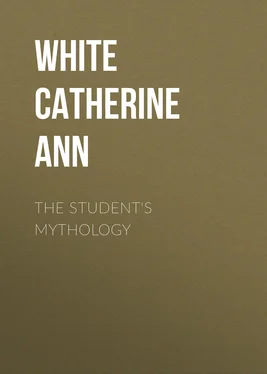Catherine White - The Student's Mythology
Здесь есть возможность читать онлайн «Catherine White - The Student's Mythology» — ознакомительный отрывок электронной книги совершенно бесплатно, а после прочтения отрывка купить полную версию. В некоторых случаях можно слушать аудио, скачать через торрент в формате fb2 и присутствует краткое содержание. Издательство: Иностранный паблик, Жанр: foreign_prose, foreign_religion, Философия, foreign_psychology, foreign_antique, на английском языке. Описание произведения, (предисловие) а так же отзывы посетителей доступны на портале библиотеки ЛибКат.
- Название:The Student's Mythology
- Автор:
- Издательство:Иностранный паблик
- Жанр:
- Год:неизвестен
- ISBN:нет данных
- Рейтинг книги:4 / 5. Голосов: 1
-
Избранное:Добавить в избранное
- Отзывы:
-
Ваша оценка:
- 80
- 1
- 2
- 3
- 4
- 5
The Student's Mythology: краткое содержание, описание и аннотация
Предлагаем к чтению аннотацию, описание, краткое содержание или предисловие (зависит от того, что написал сам автор книги «The Student's Mythology»). Если вы не нашли необходимую информацию о книге — напишите в комментариях, мы постараемся отыскать её.
The Student's Mythology — читать онлайн ознакомительный отрывок
Ниже представлен текст книги, разбитый по страницам. Система сохранения места последней прочитанной страницы, позволяет с удобством читать онлайн бесплатно книгу «The Student's Mythology», без необходимости каждый раз заново искать на чём Вы остановились. Поставьте закладку, и сможете в любой момент перейти на страницу, на которой закончили чтение.
Интервал:
Закладка:
Ques. Who was Nem´esis?
Ans. She was the daughter of Night, and the goddess of just vengeance. It was her office to follow and punish guilty men. She had wings, but generally went on foot, which signifies that the punishment of crime, although sure, is generally slow. An ancient poet says:
“Vengeance divine to punish sin moves slow;
The slower is its pace, the surer is its blow.”
Ques. What do you say of the temple of Nem´esis at Rhamnus?
Ans. This temple was but a short distance from the plain of Marathon. The Persians had brought with them a great block of Parian marble for the trophy which they intended to erect in honor of their expected victory. This marble fell into the hands of the Athenians, and a sculptor, said by some to have been Phidias, afterwards carved from it a beautiful statue of Nem´esis, which was placed in the temple of Rhamnus. A fragment was found in the ruins of this edifice, which is supposed to be the head of this statue; and has been presented as such to the British Museum.
CHAPTER XIX
Ques. Who were the Muses?
Ans. They were the daughters of Jupiter and Mnemo´syne, and were supposed to preside over the liberal arts and sciences.
Ques. How many Muses were there?
Ans. They were nine in number, and each presided over some particular department of literature, art or science. Their names were:
Calli´ope, who was the Muse of epic poetry, she holds in her hand a roll of parchment, or a trumpet.
Clio presided over history. She holds a half opened scroll.
Melpo´mene was the Muse of tragedy. She leans on a club, and holds a tragic mask.
Euter´pe was the patroness of music. She holds two flutes.
Er´ato inspired those who wrote of love. She plays on a nine-stringed lyre.
Terpsich´ore presided over choral dance and song. She appears dancing, and holds a seven-stringed lyre.
Ura´nia, the Muse of astronomy, holds a globe, and traces mathematical figures with a wand.
Thalia, the Muse of comedy, holds in one hand a comic mask, in the other a crooked staff.
Polyhym´nia presided over eloquence. She holds her fore-finger to her lips, or carries a scroll.
The Muses are sometimes represented as crowned with palms, and seated in the shade of an arbor, playing upon different instruments; or again, as dancing in a circle with joined hands, while Apollo is seated in their midst.
Ques. How have some writers accounted for the number of Muses?
Ans. They say that in ancient times there were but three Muses. The citizens of Sicyon employed three sculptors to execute statues of these goddesses, promising to choose from among the nine images, those which they should consider the most beautiful. When the statues were finished, they were found to be so skillfully wrought, that it was impossible to make a choice. They were all placed in the temple, and the poet Hesiod afterwards assigned them names and attributes.
Ques. What punishment did the Muses inflict on the nine daughters of Pierus, king of Æmathia?
Ans. These maidens challenged the Muses to a contest in music; they were defeated and transformed into magpies by the indignant goddesses. Tham´yris, a musician of Thrace, was struck blind for the same offence.
CHAPTER XX
Ques. Who was Pan?
Ans. He was a woodland deity, and was honored by the Romans as the god of shepherds and the patron of fishing and fowling. The Latins sometimes called him Incubus or the “Nightmare,” and at Rome he was worshipped as Lupercus, or Lynceus. His origin is uncertain, but he is said by some authors to have been a son of Mercury and a nymph of Arcadia.
Ques. How is Pan represented?
Ans. As half man, and half goat, having a human head ornamented with horns, and a garland of pine: he holds in one hand a crooked staff, and in the other a pipe of uneven reeds. The music which he made on this rude instrument was so sweet as to cheer the gods.
Ques. What famous action is related of Pan?
Ans. When the Gauls, under their King Brennus, made an irruption into Greece, and were about to plunder the temple of Apollo at Delphi, Pan suddenly showed himself, and so terrified them that they fled in disorder. Hence it comes that any sudden and unreasonable terror which spreads through an assemblage of persons, particularly an army, is called a panic.
Ques. What was the origin of Pan’s reeds?
Ans. A beautiful nymph, named Syrinx, was so persecuted by this god, that she prayed the water-nymphs to help her, and change her into reeds, which they did. Pan saw the transformation, and was much grieved. He took some of the reeds away for a remembrance. On applying them to his lips, he found they produced the most melodious sounds, so that he formed them into a rustic pipe. Milk and honey were offered to Pan.
Ques. Who were these?
Ans. They were hideous monsters who dwelt in forests, and were, like Pan, half man and half goat.
Ques. Who was Terminus?
Ans. He was the god of boundaries. His statue was only a square stone, or a painted log of wood. It is probable that the Romans did not suppose Terminus to be a person, but only used the name as another term for justice, which forbids any one to trespass on another’s boundaries.
Landmarks and boundary stones were considered sacred by the Romans; they were crowned with garlands on festivals, offerings were laid upon them, and it was death for any one to remove one. When Constantine embraced Christianity, and placed the cross on his standard, he replaced these Terminal stones by the Christian emblem, and the custom of erecting wayside crosses, which became afterwards almost universal, is said to date from this epoch.
Terminus had a temple on the Tarpeian rock. It is said that when Tarquin the Proud wished to build a temple to Jupiter on the spot, the god of boundaries refused to give way.
Ques. Who was this deity?
Ans. He is generally reckoned as one of the rural divinities, and was worshipped as such by the ancient Sabines. The name comes from the Latin word verto, (to turn or change,) and was bestowed upon him in allusion to his power of taking any form he pleased. Vertumnus presided over the seasons; he was the husband of Pomona. Statues of this god were erected in every town of Italy. His festival called Vertumnalia, was kept in October.
CHAPTER XXI
Ques. Who was Diana?
Ans. She was the daughter of Jupiter and Latona, and the twin-sister of Apollo. This goddess had three names. On earth she was called Diana, and was honored as the goddess of woods and hunting; in heaven she was called Luna, and was identified with the moon, as her brother Apollo was with the sun. In hell, she was called Hec´ate, and as spirits were supposed to be subject to her, she was invoked under the latter name in all magical incantations.
Ques. What were the habits of Diana?
Ans. She shunned the society of men, and frequented the woods, attended by a train of virgins who had resolved, like her, never to marry.
Ques. Who were the attendants of Diana?
Ans. Sometimes the Ocean´ides or daughters of Ocean´us; sometimes the woodland nymphs. Diana often led a chorus of the Muses and Graces, and joined them in singing the praises of her mother Latona.
Читать дальшеИнтервал:
Закладка:
Похожие книги на «The Student's Mythology»
Представляем Вашему вниманию похожие книги на «The Student's Mythology» списком для выбора. Мы отобрали схожую по названию и смыслу литературу в надежде предоставить читателям больше вариантов отыскать новые, интересные, ещё непрочитанные произведения.
Обсуждение, отзывы о книге «The Student's Mythology» и просто собственные мнения читателей. Оставьте ваши комментарии, напишите, что Вы думаете о произведении, его смысле или главных героях. Укажите что конкретно понравилось, а что нет, и почему Вы так считаете.












